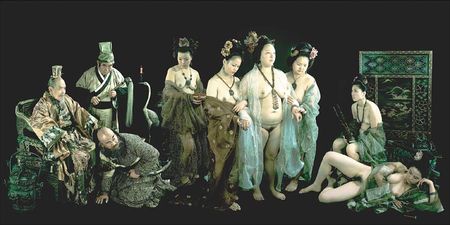"Mahjong: Contemporary Chinese Art from the Sigg Collection" @ the Peabody Essex Museum
The Four Beauties 1/4, 2004, Liu Zheng, Color photograph, Four parts, 3 ft. 3 in. x 6 ft. 6 in. each, Sigg Collection, Courtesy of the Peabody Essex Museum
SALEM, MA.- Today, an exhibition of works from the foremost collection of contemporary Chinese art comes to the Peabody Essex Museum February 21 through May 17, 2009. PEM is the exclusive East Coast venue for Mahjong: Contemporary Chinese Art from the Sigg Collection, an assemblage of provocative works organized by the Berkeley Art Museum. Featuring paintings, sculptures, photographs, installations and video, Mahjong reflects four decades of artistic exploration.
The last forty years of unprecedented social, political and economic transformation forged a generation of Chinese artists unlike any who came before. From times of restriction and relative obscurity, through more recent years of increased artistic freedom and record-breaking international auctions, Chinese artists observed the changes around them and navigated their own internal landscapes. Now China is home to one of the most dynamic and innovative contemporary art scenes in the world.
“The Sigg Collection is enormously important because it is the first attempt to coalesce the extraordinary artistic developments that have taken place in China over the last forty years. While the collection includes significant and early examples of many artists’ works, it also promotes understanding of the complexity of Chinese culture and the country's emergence as a global powerhouse," said Trevor Smith, PEM Curator of Contemporary Art.
Exhibition Themes For years, Chinese artists were obligated to work within state requirements, isolated from many artistic developments around the world. The current dynamism of Chinese contemporary art was inspired not only by the magnitude of change in recent decades, but also by a rich artistic tradition thousands of years old. As artists began to explore a less restrictive field of possibilities for their work, two overarching themes emerged:
Individual and Society In contrast with the strong abstract tendencies often seen in modern Western art, a great deal of China’s contemporary art has been figurative in character — the visual legacy of Soviet era Social Realism. Cinema, photography, pop art and advertising have fused with this style resulting in the work of artists such as Liu Xiaodong’s painting of party cadres on holiday, and Hai Bo’s restaging of a photograph taken during the era of the Cultural Revolution. The rise of a burgeoning consumer economy, the immensity of sprawling cities and the new propaganda of brand culture have also provided ample inspiration for many Chinese artists.
Tradition Revisited For over 1,500 years, the genre of Chinese painting known as shanshui (mountains/water) has used the landscape to express emotional states and intellectual concepts. In contemporary Chinese art, the theme is fertile ground for exploration by Liu Wei, who uses images of the human body to evoke a mountain landscape and Feng Mengbo, who collaborated with collector Uli Sigg using digital technology to produce a large-scale painting.
Several artists use destruction as a medium for creation. Ai Weiwei, for example, presents fifty-six Chinese Neolithic urns collected from antique markets, valued for bearing some of the earliest examples of Chinese painting. He has taken the bold step of coating many of the urns, each thousands of years old, with a layer of whitewash making the original markings illegible, and leaving viewers with only the form to contemplate.
About Uli Sigg - Uli Sigg is a Swiss businessman who was Vice President of the first joint venture between China and the West in 1979. He was the Swiss Ambassador to China, Mongolia and North Korea from 1995 to 1998. He has observed firsthand the evolution of Chinese contemporary art as an artistic idiom in its own right, and made his first purchases in the 1990s. Since then, Mr. Sigg has acquired more than 2,500 works by over 200 contemporary artists from China. His wish is to ultimately return the works to China for permanent installation in an as-yet-to-be determined institution.
Mahjong: Contemporary Chinese Art from the Sigg Collection is organized by the University of California, Berkeley Art Museum and Pacific Film Archive. The exhibition is supported in part by Carmen M. Christensen; the Wakerling and Bei Shan Tang Endowments; Barclay and Sharon Simpson; Rena Bransten; Bonhams & Butterfields, Auctioneers & Appraisers; Wen-hsin Yeh and James C. Sha; Gwong-yih and Angela Lee; The Alafi Family Foundation; Joachim & Nancy Bechtle; The Blakemore Foundation; City National Bank; Tecoah and Tom Bruce; Nancy Livingston and Fred Levin/The Shenson Foundation, and other generous donors.

/https%3A%2F%2Fprofilepics.canalblog.com%2Fprofilepics%2F1%2F0%2F100183.jpg)
/https%3A%2F%2Fstorage.canalblog.com%2F03%2F02%2F119589%2F96711876_o.jpg)
/https%3A%2F%2Fstorage.canalblog.com%2F11%2F31%2F119589%2F94773502_o.jpg)
/https%3A%2F%2Fstorage.canalblog.com%2F20%2F83%2F119589%2F94772815_o.jpg)
/https%3A%2F%2Fstorage.canalblog.com%2F26%2F72%2F119589%2F75604929_o.jpg)
/https%3A%2F%2Fstorage.canalblog.com%2F59%2F60%2F119589%2F26458628_o.jpg)



/image%2F1371349%2F20240418%2Fob_ac5c4c_telechargement.jpg)
/image%2F1371349%2F20240418%2Fob_709b64_304-1.jpg)
/image%2F1371349%2F20240418%2Fob_22f67e_303-1.jpg)
/image%2F1371349%2F20240417%2Fob_9708e8_telechargement.jpg)